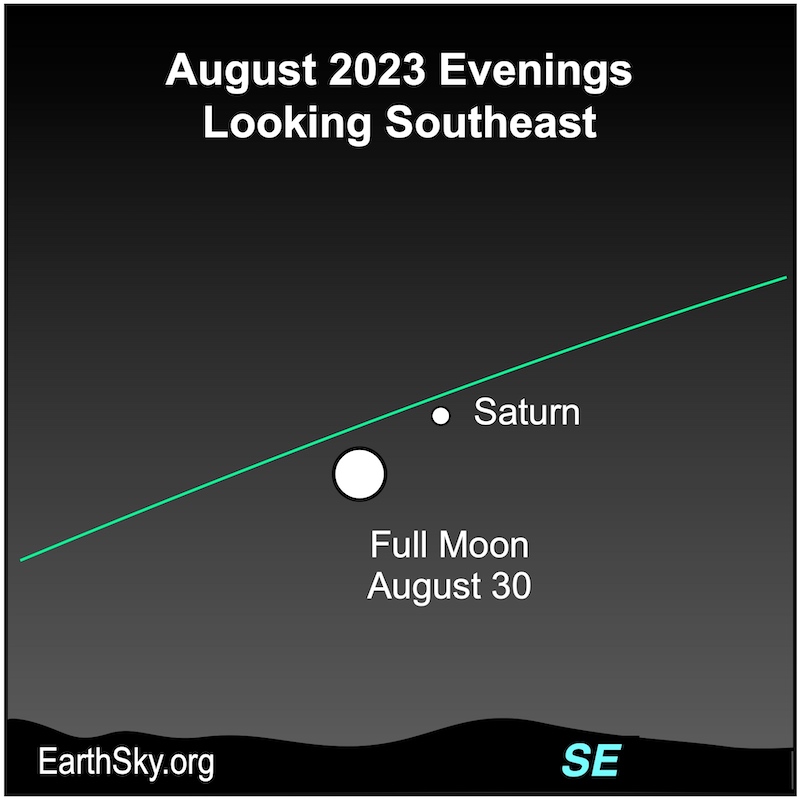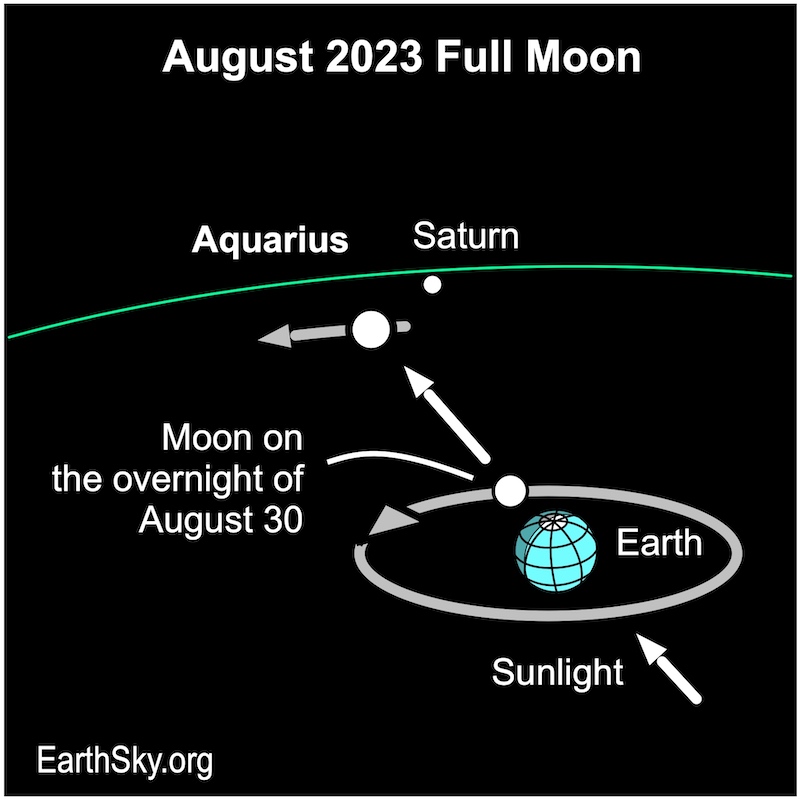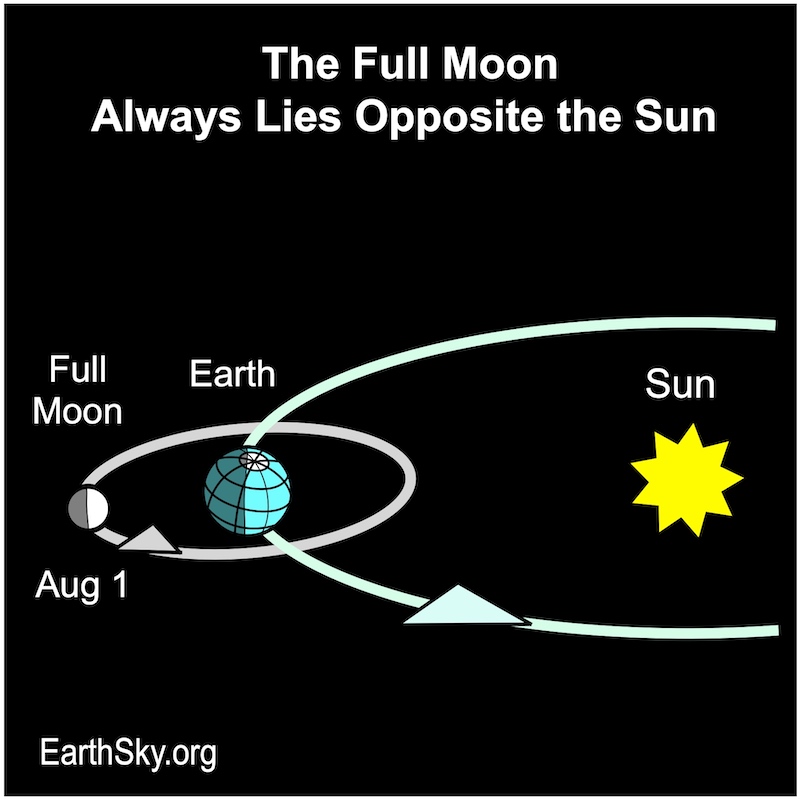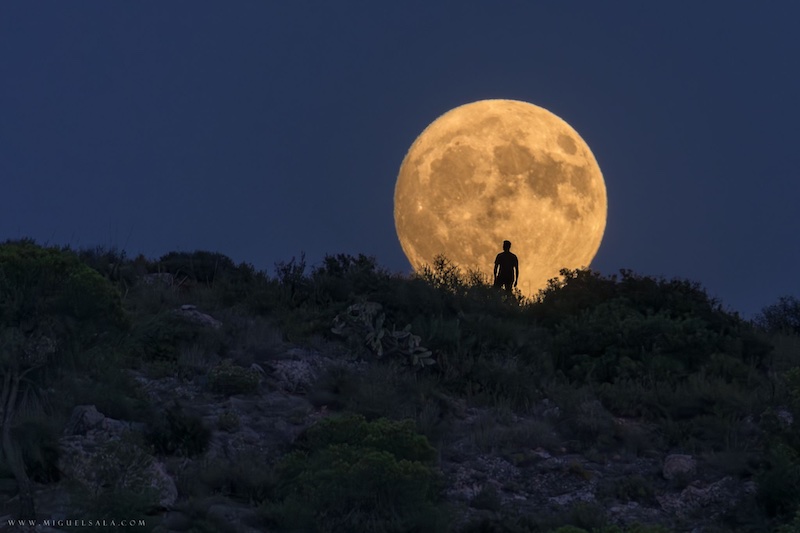The first full moon of August was August 1. And there’s another full moon on August 30-31. It’ll be the closest full moon of 2023, and therefore a supermoon. As the second full moon of the month, it’ll carry the name Blue Moon. And it’ll be near Saturn!
See an amazing photo gallery of the year’s brightest supermoon from August 30, 2023.
The 2nd full supermoon on August 30-31
Where and when to look: Look for the bright, round moon in the east shortly after sunset on August 30, 2023. It’ll be highest in the sky around midnight. And it’ll be low in the west before sunrise on August 31.
The second August 2023 lunar perigee – the moon’s closest point to Earth for the second time this month – will fall at 16 UTC (11 a.m. CDT) on August 30.
The crest of this second August full moon will fall at 1:36 UTC on August 31 (8:36 p.m. CDT on August 30). For us in the Americas, the full moon will rise near the time it’s precisely full on August 30.
Note: The August 30-31 full moon will lie in the direction of the constellation Aquarius the Water Bearer.

A full supermoon and Blue Moon near Saturn
The August 30-31, 2023, Blue Moon will light up the sky. It’s the 3rd of 4 supermoons in a row. And it will be the closest (biggest) full supermoon in 2023! It may not look bigger to the eye, but it’ll sure look brighter.
How close is it? The moon will be 222,043 miles (357,344 km) away. Comparatively, the average distance between Earth and the moon is 240,000 miles (386,242 km).
And if a month has two full moons, the second one is called a Blue Moon.
Then, look for a bright point of light near the moon; that’s the beautiful planet Saturn.
You don’t need any optical aid to enjoy this lovely pairing of the full Blue Moon supermoon and Saturn. At their closest, the duo will be two degrees – the width of four full moons – apart.
Blue Moon meets Saturn
The August 30 Blue Moon will light the sky around it, blotting out all but the brightest stars. But look carefully in the bright moonlight. And you’ll see a starlike object. It’s not a star; it’s Saturn, the 6th planet from the sun.
And Saturn is at its brightest now. That’s because Saturn reached opposition, when we flew between Saturn and the sun, on August 27. So it’s in a wonderful place to see now, rising in the east in the evening and setting in the west at sunrise.
At opposition, the ringed planet shines at its brightest for 2023, at magnitude 0.4. It’s also when Saturn is at its least distance from Earth for 2023. It’s 73 light-minutes (about 8.8 astronomical units) away.
Saturn’s disk size is largest now, appearing 19 arcseconds across. And Saturn’s rings are tilted by 8.1 degrees, relative to earthly viewers. They span 44.2 arcseconds.
Thus, opposition marks the middle of the best time of year to see Saturn, or any outer planet. And any small backyard telescope will show the rings of Saturn.


For locations outside of the polar regions, all full moons rise in the east close to the time of sunset. And likewise, all full moons set in the west close to the time of sunrise. At full moon, the sun, Earth, and moon are aligned in space, with Earth in the middle.
So the full moon is opposite the sun, visible all night. And, the moon’s day side – its fully lighted hemisphere – directly faces us. That’s why the moon appears full.
Full moon names
All the full moons have names. Popular ones for the first full moon of August include Corn Moon and Sturgeon Moon. The name Sturgeon Moon recognizes the August peak of the sturgeon fish catch in the waters of North America’s Great Lakes. In addition, we’ve also heard the name Flying Up Moon for the August full moon.
Of course, in the lore of the sky, all of those names belonged to the first full moon on August. That’s why this second full moon goes by the name Blue Moon.
Read: Full moon names by month and by season

Bottom line: The August full moon occurs twice in 2023. Both are supermoons. The 1st full moon was August 1. The 2nd – also called a Blue Moon – is August 30-31.

